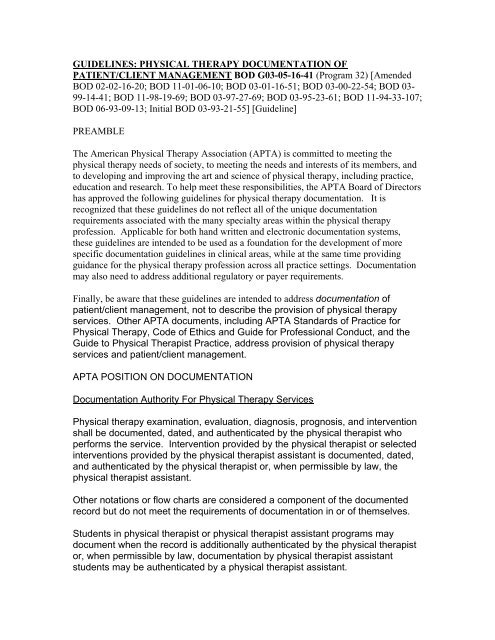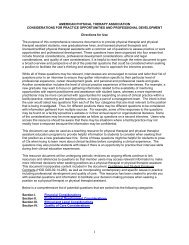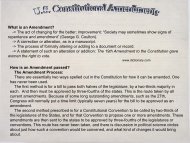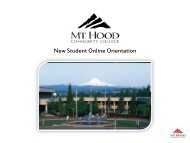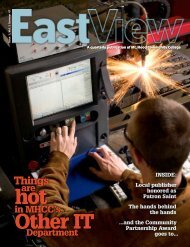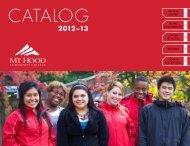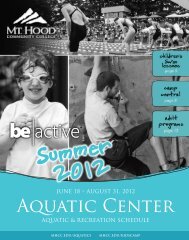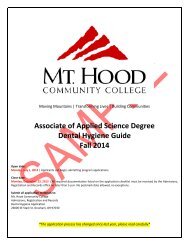GUIDELINES: PHYSICAL THERAPY DOCUMENTATION OF ...
GUIDELINES: PHYSICAL THERAPY DOCUMENTATION OF ...
GUIDELINES: PHYSICAL THERAPY DOCUMENTATION OF ...
You also want an ePaper? Increase the reach of your titles
YUMPU automatically turns print PDFs into web optimized ePapers that Google loves.
<strong>GUIDELINES</strong>: <strong>PHYSICAL</strong> <strong>THERAPY</strong> <strong>DOCUMENTATION</strong> <strong>OF</strong><br />
PATIENT/CLIENT MANAGEMENT BOD G03-05-16-41 (Program 32) [Amended<br />
BOD 02-02-16-20; BOD 11-01-06-10; BOD 03-01-16-51; BOD 03-00-22-54; BOD 03-<br />
99-14-41; BOD 11-98-19-69; BOD 03-97-27-69; BOD 03-95-23-61; BOD 11-94-33-107;<br />
BOD 06-93-09-13; Initial BOD 03-93-21-55] [Guideline]<br />
PREAMBLE<br />
The American Physical Therapy Association (APTA) is committed to meeting the<br />
physical therapy needs of society, to meeting the needs and interests of its members, and<br />
to developing and improving the art and science of physical therapy, including practice,<br />
education and research. To help meet these responsibilities, the APTA Board of Directors<br />
has approved the following guidelines for physical therapy documentation. It is<br />
recognized that these guidelines do not reflect all of the unique documentation<br />
requirements associated with the many specialty areas within the physical therapy<br />
profession. Applicable for both hand written and electronic documentation systems,<br />
these guidelines are intended to be used as a foundation for the development of more<br />
specific documentation guidelines in clinical areas, while at the same time providing<br />
guidance for the physical therapy profession across all practice settings. Documentation<br />
may also need to address additional regulatory or payer requirements.<br />
Finally, be aware that these guidelines are intended to address documentation of<br />
patient/client management, not to describe the provision of physical therapy<br />
services. Other APTA documents, including APTA Standards of Practice for<br />
Physical Therapy, Code of Ethics and Guide for Professional Conduct, and the<br />
Guide to Physical Therapist Practice, address provision of physical therapy<br />
services and patient/client management.<br />
APTA POSITION ON <strong>DOCUMENTATION</strong><br />
Documentation Authority For Physical Therapy Services<br />
Physical therapy examination, evaluation, diagnosis, prognosis, and intervention<br />
shall be documented, dated, and authenticated by the physical therapist who<br />
performs the service. Intervention provided by the physical therapist or selected<br />
interventions provided by the physical therapist assistant is documented, dated,<br />
and authenticated by the physical therapist or, when permissible by law, the<br />
physical therapist assistant.<br />
Other notations or flow charts are considered a component of the documented<br />
record but do not meet the requirements of documentation in or of themselves.<br />
Students in physical therapist or physical therapist assistant programs may<br />
document when the record is additionally authenticated by the physical therapist<br />
or, when permissible by law, documentation by physical therapist assistant<br />
students may be authenticated by a physical therapist assistant.
OPERATIONAL DEFINITIONS<br />
Guidelines<br />
APTA defines a "guideline" as a statement of advice.<br />
Authentication<br />
The process used to verify that an entry is complete, accurate and final.<br />
Indications of authentication can include original written signatures and<br />
computer "signatures" on secured electronic record systems only.<br />
The following describes the main documentation elements of patient/client<br />
management: 1) initial examination/evaluation, 2) visit/encounter, 3)<br />
reexamination, and 4) discharge or discontinuation summary.<br />
Initial Examination/Evaluation<br />
Documentation of the initial encounter is typically called the “initial<br />
examination,†“initial evaluation,†or “initial<br />
examination/evaluation.†Completion of the initial examination/<br />
evaluation is typically completed in one visit, but may occur over more<br />
than one visit. Documentation elements for the initial<br />
examination/evaluation include the following:<br />
Examination: Includes data obtained from the history, systems review,<br />
and tests and measures.<br />
Evaluation: Evaluation is a thought process that may not include formal<br />
documentation. It may include documentation of the assessment of the<br />
data collected in the examination and identification of problems<br />
pertinent to patient/client management.<br />
Diagnosis: Indicates level of impairment and functional limitation<br />
determined by the physical therapist. May be indicated by selecting one<br />
or more preferred practice patterns from the Guide to Physical Therapist<br />
Practice.<br />
Prognosis: Provides documentation of the predicted level of<br />
improvement that might be attained through intervention and the amount<br />
of time required to reach that level. Prognosis is typically not a separate<br />
documentation elements, but the components are included as part of the<br />
plan of care.<br />
Plan of care: Typically stated in general terms, includes goals,<br />
interventions planned, proposed frequency and duration, and discharge<br />
plans.
Visit/Encounter<br />
Documentation of a visit or encounter, often called a progress note or<br />
daily note, documents sequential implementation of the plan of care<br />
established by the physical therapist, including changes in patient/client<br />
status and variations and progressions of specific interventions used.<br />
Also may include specific plans for the next visit or visits.<br />
Reexamination<br />
Documentation of reexamination includes data from repeated or new<br />
examination elements and is provided to evaluate progress and to<br />
modify or redirect intervention.<br />
Discharge or Discontinuation Summary<br />
Documentation is required following conclusion of the current episode<br />
in the physical therapy intervention sequence, to summarize progression<br />
toward goals and discharge plans.<br />
GENERAL <strong>GUIDELINES</strong><br />
• Documentation is required for every visit/encounter.<br />
• All documentation must comply with the applicable jurisdictional/regulatory<br />
requirements.<br />
• All handwritten entries shall be made in ink and will include original<br />
signatures. Electronic entries are made with appropriate security and<br />
confidentiality provisions.<br />
• Charting errors should be corrected by drawing a single line through the<br />
error and initialing and dating the chart or through the appropriate<br />
mechanism for electronic documentation that clearly indicates that a<br />
change was made without deletion of the original record.<br />
• All documentation must include adequate identification of the patient/client<br />
and the physical therapist or physical therapist assistant:<br />
o The patient's/client's full name and identification number, if<br />
applicable, must be included on all official documents.<br />
o All entries must be dated and authenticated with the provider's full<br />
name and appropriate designation:<br />
• Documentation of examination, evaluation, diagnosis,<br />
prognosis, plan of care, and discharge summary must be<br />
authenticated by the physical therapist who provided the<br />
service.<br />
• Documentation of intervention in visit/encounter notes must<br />
be authenticated by the physical therapist or physical<br />
therapist assistant who provided the service.<br />
• Documentation by physical therapist or physical therapist<br />
assistant graduates or other physical therapists and physical<br />
therapist assistants pending receipt of an unrestricted
license shall be authenticated by a licensed physical<br />
therapist, or, when permissible by law, documentation by<br />
physical therapist assistant graduates may be authenticated<br />
by a physical therapist assistant.<br />
• Documentation by students (SPT/SPTA) in physical therapist<br />
or physical therapist assistant programs must be additionally<br />
authenticated by the physical therapist or, when permissible<br />
by law, documentation by physical therapist assistant<br />
students may be authenticated by a physical therapist<br />
assistant.<br />
• Documentation should include the referral mechanism by which physical<br />
therapy services are initiated. Examples include:<br />
o Self-referral/direct access<br />
o Request for consultation from another practitioner<br />
• Documentation should include indication of no shows and cancellations.<br />
INITIAL EXAMINATION/EVALUATION<br />
Examination (History, Systems Review, and Tests and Measures)<br />
History:<br />
Documentation of history may include the following:<br />
• General demographics<br />
• Social history<br />
• Employment/work (Job/School/Play)<br />
• Growth and development<br />
• Living environment<br />
• General health status (self-report, family report, caregiver<br />
report)<br />
• Social/health habits (past and current)<br />
• Family history<br />
• Medical/surgical history<br />
• Current condition(s)/Chief complaint(s)<br />
• Functional status and activity level<br />
• Medications<br />
• Other clinical tests<br />
Systems Review:<br />
Documentation of systems review may include gathering data for the<br />
following systems:<br />
• Cardiovascular/pulmonary<br />
o Blood Pressure<br />
o Edema
o Heart Rate<br />
o Respiratory Rate<br />
• Integumentary<br />
o Pliability (texture)<br />
o Presence of scar formation<br />
o Skin color<br />
o Skin integrity<br />
• Musculoskeletal<br />
o Gross range of motion<br />
o Gross strength<br />
o Gross symmetry<br />
o Height<br />
o Weight<br />
• Neuromuscular<br />
o Gross coordinated movement (eg, balance, locomotion,<br />
transfers, and transitions)<br />
o Motor function (motor control, motor learning)<br />
Documentation of systems review may also address communication ability, affect,<br />
cognition, language, and learning style:<br />
• Ability to make needs known<br />
• Consciousness<br />
• Expected emotional/behavioral responses<br />
• Learning preferences (eg, education needs, learning barriers)<br />
• Orientation (person, place, time)<br />
Tests and Measures:<br />
Documentation of tests and measures may include findings for the following<br />
categories:<br />
• Aerobic Capacity/Endurance<br />
Examples of examination findings include:<br />
o Aerobic capacity during functional activities<br />
o Aerobic capacity during standardized exercise test protocols<br />
o Cardiovascular signs and symptoms in response to increased<br />
oxygen demand with exercise or activity<br />
o Pulmonary signs and symptoms in response to increased oxygen<br />
demand with exercise or activity<br />
• Anthropometric Characteristics<br />
Examples of examination findings include:
o<br />
o<br />
o<br />
Body composition<br />
Body dimensions<br />
Edema<br />
• Arousal, attention, and cognition<br />
Examples of examination findings include:<br />
o Arousal and attention<br />
o Cognition<br />
o Communication<br />
o Consciousness<br />
o Motivation<br />
o Orientation to time, person, place, and situation<br />
o Recall<br />
• Assistive and adaptive devices<br />
Examples of examination findings include:<br />
o Assistive or adaptive devices and equipment use during functional<br />
activities<br />
o Components, alignment, fit, and ability to care for the assistive or<br />
adaptive devices and equipment<br />
o Remediation of impairments, functional limitations, or disabilities<br />
with use of assistive or adaptive devices and equipment<br />
o Safety during use of assistive or adaptive devices and equipment<br />
• Circulation (Arterial, Venous, Lymphatic)<br />
Examples of examination findings include:<br />
o Cardiovascular signs<br />
o Cardiovascular symptoms<br />
o Physiological responses to position change<br />
• Cranial and Peripheral Nerve Integrity<br />
Examples of examination findings include:<br />
o Electrophysiological integrity<br />
o Motor distribution of the cranial nerves<br />
o Motor distribution of the peripheral nerves<br />
o Response to neural provocation<br />
o Response to stimuli, including auditory, gustatory, olfactory,<br />
pharyngeal, vestibular, and visual<br />
o Sensory distribution of the cranial nerves<br />
o Sensory distribution of the peripheral nerves
• Environmental, Home, and Work (Job/School/Play) Barriers<br />
Examples of examination findings include:<br />
o Current and potential barriers<br />
o Physical space and environment<br />
• Ergonomics and Body mechanics<br />
Examples of examination findings for ergonomics include:<br />
o Dexterity and coordination during work<br />
o Functional capacity and performance during work actions, tasks, or<br />
activities<br />
o Safety in work environments<br />
o Specific work conditions or activities<br />
o Tools, devices, equipment, and work-stations related to work<br />
actions, tasks, or activities<br />
Examples of examination findings for body mechanics include:<br />
o<br />
Body mechanics during self-care, home management, work,<br />
community, or leisure actions, tasks, or activities<br />
• Gait, locomotion, and balance<br />
Examples of examination findings include:<br />
o Balance during functional activities with or without the use of<br />
assistive, adaptive, orthotic, protection, supportive, or prosthetic<br />
devices or equipment<br />
o Balance (dynamic and static) with or without the use of assistive,<br />
adaptive, orthotic, protective, supportive, or prosthetic devices or<br />
equipment<br />
o Gait and locomotion during functional activities with or without the<br />
use of assistive, adaptive, orthotic, protective, supportive, or<br />
prosthetic devices or equipment<br />
o Gait and locomotion with or without the use of assistive, adaptive,<br />
orthotic, protective, supportive, or prosthetic devices or equipment<br />
o Safety during gait, locomotion, and balance<br />
• Integumentary Integrity<br />
Examples of examination findings include:<br />
Associated skin:
o<br />
o<br />
o<br />
Activities, positioning, and postures that produce or relieve trauma<br />
to the skin<br />
Assistive, adaptive, orthotic, protective, supportive, or prosthetic<br />
devices and equipment that may produce or relieve trauma to the<br />
skin<br />
Skin characteristics<br />
Wound:<br />
o<br />
o<br />
o<br />
o<br />
o<br />
Activities, positioning, and postures that aggravate the wound or<br />
scar or that produce or relieve trauma<br />
Burn<br />
Signs of infection><br />
Wound characteristics<br />
Wound scar tissue characteristics<br />
• Joint Integrity and Mobility<br />
Examples of examination findings include:<br />
o Joint integrity and mobility<br />
o Joint play movements<br />
o Specific body parts<br />
• Motor Function<br />
Examples of examination findings include:<br />
o Dexterity, coordination, and agility<br />
o Electrophysiological integrity<br />
o Hand function<br />
o Initiation, modification, and control of movement patterns and<br />
voluntary postures<br />
• Muscle Performance<br />
Examples of examination findings include:<br />
o Electrophysiological integrity<br />
o Muscle strength, power, and endurance<br />
o Muscle strength, power, and endurance during functional activities<br />
o Muscle tension
o<br />
o<br />
o<br />
o<br />
Neuromotor development and sensory integration<br />
Examples of examination findings include:<br />
Acquisition and evolution of motor skills<br />
Oral motor function, phonation, and speech production<br />
Sensorimotor integration<br />
• Orthotic, protective, and supportive devices<br />
Examples of examination findings include:<br />
o Components, alignment, fit, and ability to care for the orthotic,<br />
protective, and supportive devices and equipment<br />
o Orthotic, protective, and supportive devices and equipment use<br />
during functional activities<br />
o Remediation of impairments, functional limitations, or disabilities<br />
with use of orthotic, protective, and supportive devices and<br />
equipment<br />
o Safety during use of orthotic, protective, and supportive devices<br />
and equipment<br />
• Pain<br />
Examples of examination findings include:<br />
o Pain, soreness, and nocioception<br />
o Pain in specific body parts<br />
• Posture<br />
Examples of examination findings include:<br />
o Postural alignment and position (dynamic)<br />
o Postural alignment and position (static)<br />
o Specific body parts<br />
• Prosthetic requirements<br />
Examples of examination findings include:<br />
o Components, alignment, fit, and ability to care for prosthetic device<br />
o Prosthetic device use during functional activities<br />
o Remediation of impairments, functional limitations, or disabilities<br />
with use of the prosthetic device<br />
o Residual limb or adjacent segment<br />
o Safety during use of the prosthetic device
• Range of motion (including muscle length)<br />
Examples of examination findings include:<br />
o Functional ROM<br />
o Joint active and passive movement<br />
o Muscle length, soft tissue extensibility, and flexibility<br />
• Reflex integrity<br />
Examples of examination findings include:<br />
o Deep reflexes<br />
o Electrophysiological integrity<br />
o Postural reflexes and reactions, including righting, equilibrium, and<br />
protective reactions<br />
o Primitive reflexes and reactions<br />
o Resistance to passive stretch<br />
o Superficial reflexes and reactions<br />
• Self-care and home management (including activities of daily living and<br />
instrumental activities of daily living)<br />
Examples of examination findings include:<br />
o<br />
o<br />
o<br />
Ability to gain access to home environments<br />
Ability to perform self-care and home management activities with or<br />
without assistive, adaptive, orthotic, protective, supportive, or<br />
prosthetic devices and equipment<br />
Safety in self-care and home management activities and<br />
environments<br />
• Sensory integrity<br />
Examples of examination findings include:<br />
o Combined/cortical sensations<br />
o Deep sensations<br />
o Electrophysiological integrity<br />
• Ventilation and respiration<br />
Examples of examination findings include:<br />
o Pulmonary signs of respiration/gas exchange<br />
o Pulmonary signs of ventilatory function
o<br />
Pulmonary symptoms<br />
• Work (job/school/play), community, and leisure integration or reintegration<br />
(including instrumental activities of daily living)<br />
Examples of examination findings include:<br />
o Ability to assume or resume work (job/school/plan), community, and<br />
leisure activities with or without assistive, adaptive, orthotic,<br />
protective, supportive, or prosthetic devices and equipment<br />
o Ability to gain access to work (job/school/play), community, and<br />
leisure environments<br />
o Safety in work (job/school/play), community, and leisure activities<br />
and environments<br />
Evaluation<br />
o<br />
Evaluation is a thought process that may not include formal<br />
documentation.However, the evaluation process may lead to<br />
documentation of impairments, functional limitations, and<br />
disabilities using formats such as:<br />
• A problem list<br />
• A statement of assessment of key factors (e.g., cognitive<br />
factors, co- morbidities, social support) influencing the<br />
patient/client status.<br />
Diagnosis<br />
o<br />
Documentation of a diagnosis determined by the physical therapist<br />
may include impairment and functional limitations.Examples<br />
include:<br />
• Impaired Joint Mobility, Motor Function, Muscle<br />
Performance, and Range of Motion Associated With<br />
Localized Inflammation (4E)<br />
• Impaired Motor Function and Sensory Integrity Associated<br />
With Progressive Disorders of the Central Nervous System<br />
(5E)<br />
• Impaired Aerobic Capacity/Endurance Associated With<br />
Cardiovascular Pump Dysfunction or Failure (6D)<br />
• Impaired Integumentary Integrity Associated With Partial-<br />
Thickness Skin Involvement and Scar Formation (7C)<br />
Prognosis<br />
o<br />
Documentation of the prognosis is typically included in the plan of<br />
care.See below.<br />
Plan of Care
o<br />
Documentation of the plan of care includes the following:<br />
• Overall goals stated in measurable terms that indicate the<br />
predicted level of improvement in function<br />
• A general statement of interventions to be used<br />
• Proposed duration and frequency of service required to<br />
reach the goals<br />
• Anticipated discharge plans<br />
VISIT/ENCOUNTER<br />
• Documentation of each visit/encounter shall include the following<br />
elements:<br />
o Patient/client self-report (as appropriate).<br />
o Identification of specific interventions provided, including<br />
frequency, intensity, and duration as appropriate.Examples<br />
include:<br />
• Knee extension, three sets, ten repetitions, 10#<br />
weight<br />
• Transfer training bed to chair with sliding board<br />
• Equipment provided<br />
o Changes in patient/client impairment, functional limitation,<br />
and disability status as they relate to the plan of care.<br />
o Response to interventions, including adverse reactions, if<br />
any.<br />
o Factors that modify frequency or intensity of intervention and<br />
progression goals, including patient/client adherence to<br />
patient/client-related instructions.<br />
o Communication/consultation with<br />
providers/patient/client/family/ significant other.<br />
o Documentation to plan for ongoing provision of services for<br />
the next visit(s), which is suggested to include, but not be<br />
limited to:<br />
• The interventions with objectives<br />
• Progression parameters<br />
• Precautions, if indicated<br />
REEXAMINATION<br />
• Documentation of reexamination shall include the following<br />
elements:<br />
o Documentation of selected components of examination to<br />
update patient's/client's impairment, function, and/or<br />
disability status.<br />
o Interpretation of findings and, when indicated, revision of<br />
goals.
o<br />
When indicated, revision of plan of care, as directly<br />
correlated with goals as documented.<br />
DISCHARGE/DISCONTINUATION SUMMARY<br />
• Documentation of discharge or discontinuation shall include the<br />
following elements:<br />
o Current physical/functional status.<br />
o Degree of goals achieved and reasons for goals not being<br />
achieved.<br />
o Discharge/discontinuation plan related to the patient/client's<br />
continuing care. Examples include:<br />
• Home program.<br />
• Referrals for additional services.<br />
• Recommendations for follow-up physical therapy<br />
care.<br />
• Family and caregiver training.<br />
• Equipment provided.


